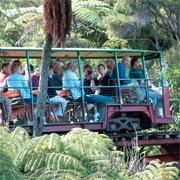Auckland to Whakatane & the Bay of Plenty - Day One
Auckland to Coromandel Town

Leaving Auckland we drive south through Clevedon to the Seabird Coast. The road travels alongside the still waters and startling-white shell banks of the Firth of Thames from Kaiaua to Miranda with its world-renowned, 8500-hectare, intertidal sanctuary for migratory birds. We stop at the Miranda Shorebird Centre, where detailed display boards explain how the region is a temporary abode for thousands of migrating shorebirds navigating their way from Eastern Siberia and the Alaskan tundra to spend the summer in New Zealand. The bar-tailed godwit and lesser knot are the most commonly sighted tourists. “It’s a long way to come for a little R&R,” jokes Bob, as we stand on the shoreline scouting for birds. There are hundreds including pied oyster-catchers who return to the Firth after breeding in the South Island.
We drive past the popular Miranda Hot Springs, where the waters of these once swamplike natural springs were transformed in 1959 into what was then the largest thermal pool in the Southern Hemisphere, and on to Waitakaruru where two one-way bridges pass over the same river.
Stretching our legs in the Waitakaruru antique store, we hear from an old-timer that the army built the second bridge for the Queen’s visit to New Zealand in 1953. ”Up in a day,” he grumbles, “Don’t see that now!”
We cross the Kopu Bridge and ten minutes later we’re in Thames, a town that had a larger population than Auckland back in the height of the 1880s gold boom. There are a number of old buildings and relics from that era, particularly at its northern end around Grahamstown.
We pop into Eco People, with its dazzling array of hand-crafted soaps. One novel product is ‘Washy Squashy’ moulding soap; it’s similar to kids’ play dough, but easier on the clothes and home. Some of the soap, like the blackberry, sweet kiwifruit, feijoa and mandarin bars, smell almost edible and I keep an eye on Bob - when it comes to him and food, nothing would surprise me!
In Tararu we park on the quiet shore and enjoy a cup of thermos tea, then continue north. Our route takes us through contorted pohutukawa trees growing so thickly on the cliffs that the telephone lines must leave the bank and journey across the water.
A steep hill provides superb views of the Coromandel Peninsula, the Firth of Thames and Auckland hiding behind Ponui and Waiheke Islands. We descend to Coromandel Town, home to around 1400 keen boaties, conservationists, lifestylers and craftspeople.
Strolling around town, Bob’s kept busy taking snapshots of the fine Victorian buildings and relics from the gold mining and timber industries. We call into Weta, the Source and Art Xtreme, where local artisans display their wares.
Over Panini’s at Success Café, we decide to spend the afternoon taking a train ride at Driving Creek Railway, and soaking up local history at the Coromandel Stamper Battery. When we arrive, Bob’s amazed by the size of the river-powered waterwheel standing 7.5 metres high. Ashley Franklyn shows us around. “Gold was discovered at Driving Creek in 1852 and the battery was erected in 1898 to determine the quality of ore,” he says, demonstrating how it works and answering our many questions.
“There’s not much he doesn’t know about gold mining in this town,” says Bob as we leave and drive the short distance to Driving Creek Railway, a project that has been 40 years in the making and the brain child of Barry Brickell, a highly creative potter.
Fortunately we get to meet Barry himself, a colourful local character. He tells us that he never intended his railway to become a tourist attraction and that the first sections of track were built to gain all-weather access to the clay.
We hop aboard and with a toot we’re off, chugging along a narrow-gauge 15-inch track, which winds up the hills behind the potteries. There are tunnels, spirals, and a double-decker viaduct en route and the track zigzags its way up the hill to Barry’s latest creation, the ‘Eyeful Tower’, a wooden terminus providing truly eye-popping views of the Coromandel.
Sad Note: Coromandel potter and New Zealand identity Barry Brickell died Saturday 23rd January 2016 in Coromandel aged 80. He leaves the legacy of Driving Creek Railway and Potteries for our continued enjoyment.
Later we check in to our accommodation for the night, a self-contained kauri cottage built in the 1850s, and dine on bowls of freshly steamed green-lipped mussels – the kai moana (seafood) for which Coromandel Town is renowned.
We finish our evening at the beach where locals are hunting for flounder by flashlight. They lend us some gear – a couple of torches and knives strapped to sticks of manuka – and we slowly wade through the water looking for the tell-tale outlines in the sand of these flat fish. I spear the first and Bob (ever the great fisherman) races over to help get it into the bag. Shortly after there’s a loud whoop and he scores another. We thank our newfound friends and head home with our breakfast.